Reducing the Loss of Crop Nutrients to Waterways
Crop nutrients help plants grow and produce the food, fiber and fuel we all need. Unfortunately they can also nourish algal blooms in waterways, which is in no one’s best interest. We support and promote the 4R Nutrient Stewardship framework to achieve the agricultural benefits of fertilizer and reduce nutrient loss to the environment.
Mosaic wants farmers to achieve maximum plant nutrition and yield benefits from our crop nutrition products. But when crop nutrients run off farmland into a waterway, they can contribute to impaired water quality. It is in everyone’s best interest that nutrients remain in the crop’s root zone.
Fertilizer is a vital agricultural input and investment—one that requires agronomic knowledge and careful planning. Because soil fertility is not self-sustaining, nutrients must be replaced to ensure each year’s crop grows a nutritious supply of food. Fertilizers replenish soils with those nutrients that are removed with each harvest.
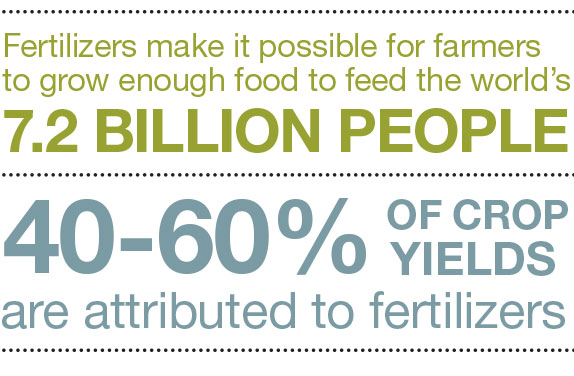
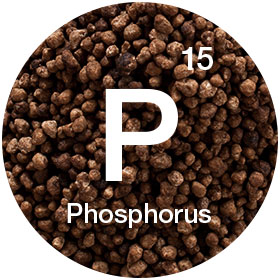
Phosphorus, the mineral found in phosphate fertilizer, is an essential mineral for all life
In plants, phosphorus supports root growth, plant development, resistance to diseases and water use efficiency—producing higher crop quality and increased yields.

Various sources of nutrients can load local waterways, including runoff from farmland livestock operations and municipal wastewater. Greater concentrations of nutrients can be present in areas where soil fertility is needed for crop production, and where agriculture is a significant use of land. Nutrient losses can stimulate algal blooms in water, impacting the surrounding watersheds, environment and community.
Good nutrient management is possible, but best management practices differ from farm to farm. It takes testing, research, planning, measurement and collaboration to determine which nutrient management practices are most effective, adaptive and scalable.
Many stakeholders, including agriculture companies, academic institutions, nonprofit organizations and governments, are working collaboratively and with farmers to implement solutions to nutrient losses. For example, groups are engaged on:
- Training and education on 4R Nutrient Stewardship
- Focusing on local conservation programs
- Combining on- and off-field practices
- Conducting small watershed research projects
- Considering nutrient trading
- Improving data collection
- Enhancing soil testing methods
- Evaluating weather criteria as part of crop nutrient application planning
- Using variable rate planning and technology
Mosaic has been actively engaged on phosphate product stewardship for years, and we recognize there is more to be done. We are redoubling efforts to further extend our market leadership, provide product expertise, and advocate for increased efficiency of phosphate nutrients in cropping systems on farmland.
“Mosaic takes its responsibility to support and promote the proper use of crop nutrients seriously,” said Jim Prokopanko, President and Chief Executive Officer of The Mosaic Company. “We are committed to helping retail customers and farmers achieve the benefits of phosphate fertilizer use through 4R Nutrient Stewardship and balanced crop nutrition.”
Fertilizers and Algal Blooms
High nutrient concentrations in water—known as eutrophication—can stimulate rapid growth of aquatic algal “blooms” that feed on nutrients, warmth and light.
Algae grow naturally in freshwater and marine environments, but certain algal blooms are considered harmful. Excessive growth can harm ecosystems and produce bacterial toxins that can cause illness in humans, domestic pets and wildlife.
Problems associated with algal blooms include discolored water, reduced water clarity and light penetration, and a musty drinking water taste and odor. As blooms decompose, they may consume enough dissolved oxygen in water to create a condition called hypoxia or so-called “dead zones” where fish and other life can’t survive.
Crop nutrients must be applied using science-based 4R Nutrient Stewardship practices to mitigate potentially negative environmental impacts stemming from improper use. If crop nutrients are not managed appropriately, they can run off farmland and potentially impair watersheds.


Since 2004, The Mosaic Company and The Mosaic Company Foundation have invested more than $17 million in water-focused programs and partnerships promoting nutrient stewardship, habitat conservation and watershed restoration in priority watersheds. In addition, we have partnered with 89 organizations on water-focused initiatives, including 20 organizations on nutrient stewardship initiatives, since 2004.
“We manage Mosaic’s business with transparency and accountability, creating value that is shared among employees, customers, communities, shareholders and business partners,” said Prokopanko. “The steps we’ve taken to promote good stewardship of our fertilizer products reconfirms our commitment to sustainability and social responsibility. Mosaic is embracing its obligation to drive continuous improvement across our company, and across the fertilizer industry.”
Our Nutrient Stewardship Actions:
Promote
4R Nutrient Stewardship through communication and education
Partner
with non-governmental organizations in priority watersheds
Invest
in product research and development to increase yields and reduce nutrient loss
Engage
and invest in strategic 4R Nutrient Stewardship programs that:
- Add production and environmental value to our customers
- Reinforce industry associations’ efforts to provide nutrient stewardship leadership
- Provide regulators with science-based solutions
4R Nutrient Stewardship: Guided by Science, Proven By Research
Mosaic supports and promotes the 4R Nutrient Stewardship framework, which helps define practices to meet the economic, environmental and social goals of a farming operation.
4R Nutrient Stewardship encompasses fertilizer best management practices to achieve specific cropping system goals, including environmental protection. To achieve those goals, the 4Rs framework incorporates the Right nutrient source, at the Right rate, at the Right time, and in the Right place.
The concept of 4R Nutrient Stewardship is simple, but implementation is knowledge-intensive and site-specific. Other agronomic and conservation practices, such as tillage practices and cover crops, play a valuable role in good nutrient stewardship. As a result, fertilizer best management practices are most effective when applied with other agronomic and conservation practices.
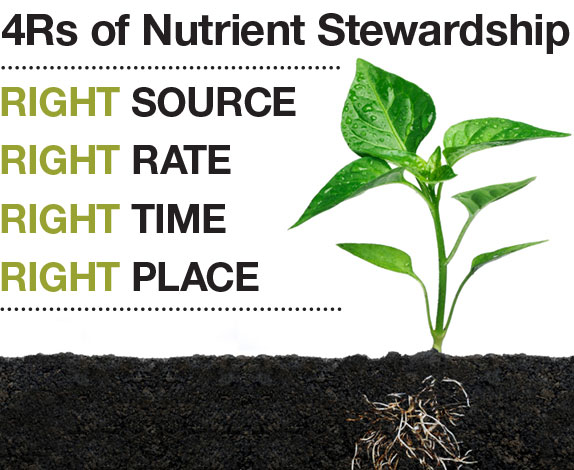
Learn how the 4Rs provide a foundation for optimized yields, while maximizing profitability and sustainability.
Partnering with The Nature Conservancy to Improve Water Quality
In 2013, The Mosaic Company Foundation supported The Nature Conservancy’s Western Lake Erie Basin 4R Nutrient Stewardship Program to pilot the voluntary 4R Certification Standard for agricultural retailers in collaboration with multiple sectors. The goal is to improve water quality in the Western Lake Erie Basin in Indiana, Michigan and Ohio.
“The Nature Conservancy is a leading conservation organization working around the world to protect ecologically important lands and waters for nature and people. Our expertise in nutrient stewardship and conservation agriculture best practices enables us to share success across geographies,” said Larry Clemens, North American Agriculture Program Director at The Nature Conservancy. “The Mosaic Company Foundation’s support of this certification program ensures that information sharing and the incorporation of new research and technologies will help to improve water quality in Lake Erie.”
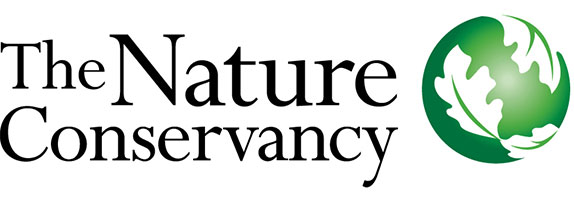
Learn more on our investments and partnership with The Nature Conservancy
Visit the Nature
Conservancy Website
Suggested Best Practices to Keep Phosphorus on Farmland
Source: NutrientStewardship.com
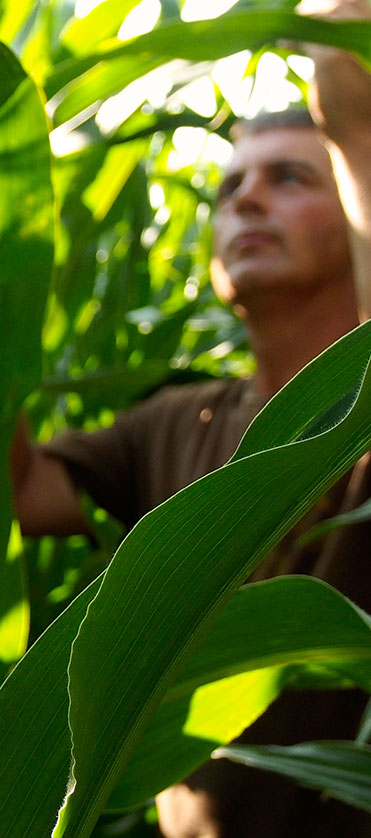
DO soil test to determine nutrient requirements for the next crop
DO consider all nutrient sources available to the crop when deciding on how much to apply
DO inject or incorporate phosphorus whenever possible
DO delay application for low-lying fields that are prone to flooding to just before planting; either incorporate, band-place or inject
DO use cover crops to improve soil health, increase water-holding capacity and reduce surface runoff
DO include starter or row phosphate fertilizer wherever practical
DO schedule phosphate fertilizer applications for no-till programs as close to crop utilization as practical
DO schedule phosphate fertilizer broadcast applications in conventional/reduced tillage programs for when shallow tillage is possible
DON'T schedule phosphate fertilizer applications just prior to heavy rainfall
DON'T schedule phosphate fertilizer applications when soils are frozen or snow covered
DON'T broadcast apply phosphate fertilizer near surface drains or exposed tile stand pipes; consider injection or banded application methods
DON'T apply phosphate fertilizer near ditches, streams or waterways
Additional Education Resources
- Overview of Requirements for 4R Nutrient Stewardship Certification
- 4R Farmers and The Lake: Sustainable Crop Nutrition for The Western Lake Erie Basin
- 4Rs of Nutrient Stewardship: Economically, Environmentally & Socially Sustainable Crop Nutrition
- 4R Plant Nutrition: A Manual for Improving the Management of Plant Nutrition, Second Edition
- 4R Nutrient Stewardship Portal by International Plant Nutrition Institute
- 4R Nutrient Stewardship by The Fertilizer Institute
Advancing Industry & Agriculture Supply Chain Efforts
Mosaic collaborates with a wide range of agriculture stakeholders, including International Plant Nutrition Institute, Canadian Fertilizer Institute, International Fertilizer Association, The Fertilizer Institute and Agricultural Retailers Association to promote and provide information on 4R Nutrient Stewardship and sustainable agricultural systems.


